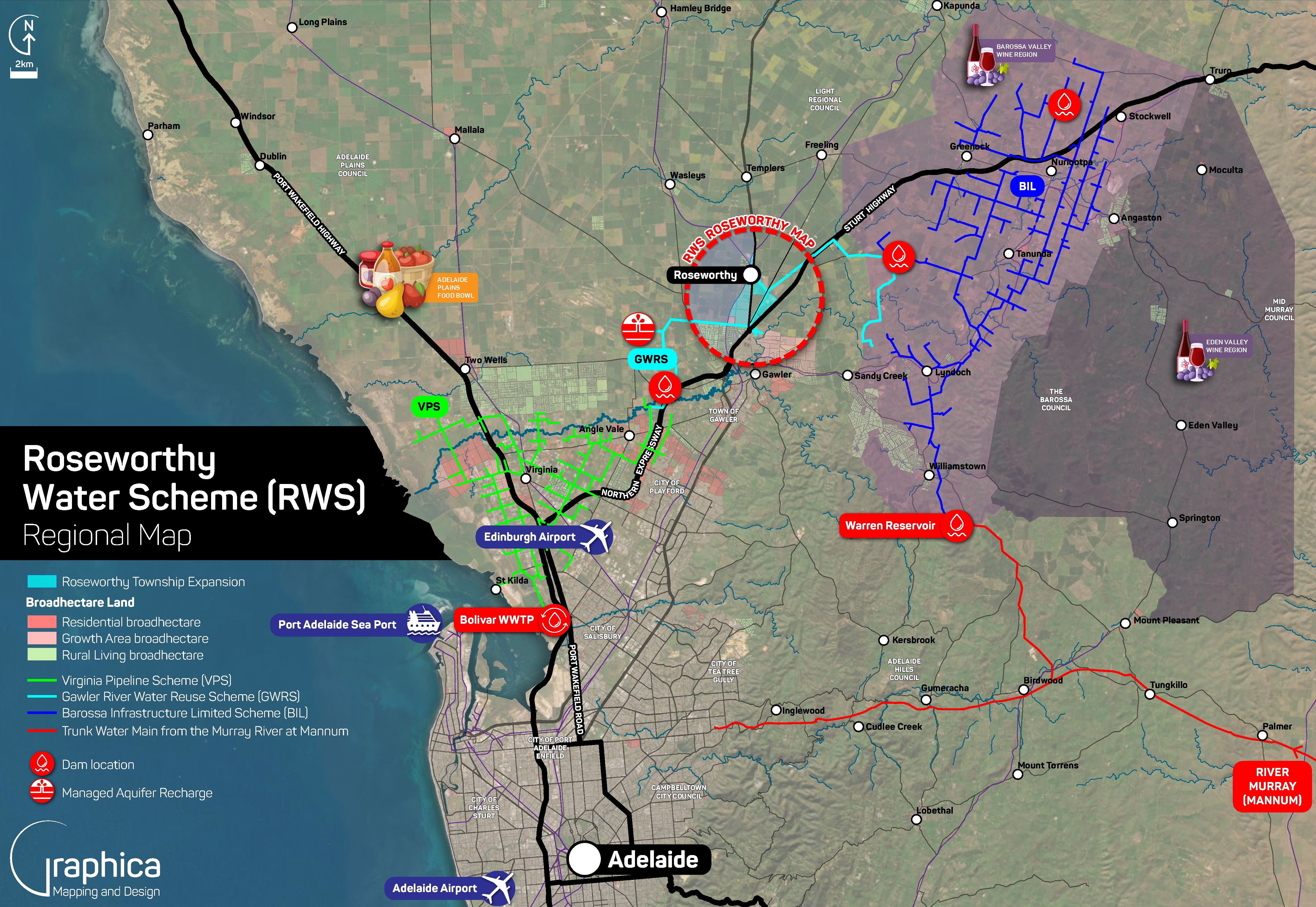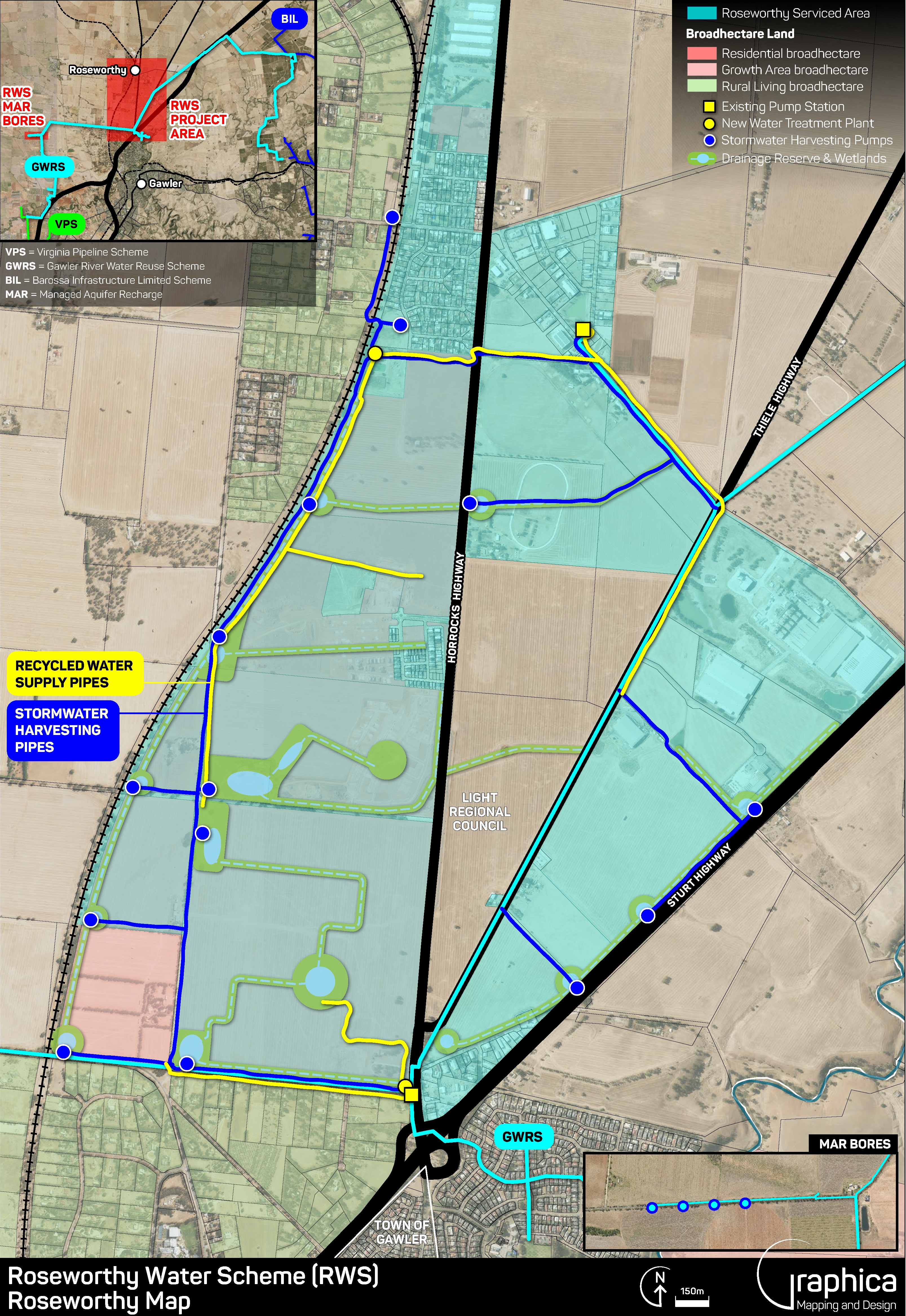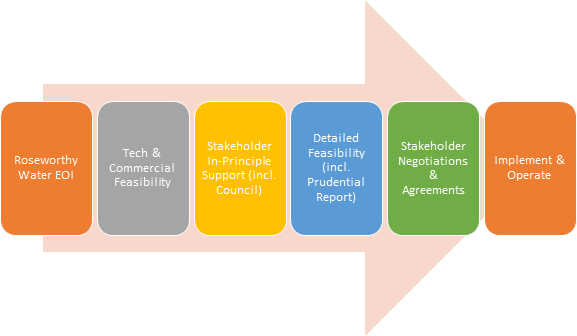Key Points
- The Roseworthy Water Scheme is a Public-Private Partnership project involving commercial agreements between Light Regional Council (Public), participating landowners/developers of the Roseworthy Township Expansion and Kingsford Regional Industrial Estate (Private), and Water Infrastructure Owner - Bunyip Water (Private).
- The project will harvest stormwater runoff from the Roseworthy Township Expansion and Kingsford Regional Industrial Estate land developments, storing and treating it before supplying back to these areas for irrigation of parks and reserves for high amenity greening and cooling and potential industrial use. The harvesting of this stormwater meets a key requirement for landowners/developers to ensure that no additional stormwater discharges occur from the site (compared to the situation prior to development).
- Excess stormwater harvested will be reused on vineyards in the western Barossa Valley, with up to 800 ML per annum supplied at full development (equivalent to 320 Olympic-sized swimming pools).
- Project infrastructure will include stormwater harvesting wetlands, pump stations, water treatment plants, above and/or below ground storages and a network of pipelines predominantly located in the Roseworthy and Kingsford areas. This infrastructure will connect into the existing Bunyip Water scheme.
- The Council’s role in the project is as financer/facilitator and has secured funding contributions from each private stakeholder as well as the State and Federal Governments, which means the Council is forecast to achieve a positive net present value from its financing/facilitation role.
- The project will take several years to complete, with the first stage planned to be commissioned and operating for the 2024 winter. The final stages will be complete once all participating landowners/developers have commenced and largely completed their land divisions.
Background
Due to its scale the Roseworthy Water Scheme, also known as Bunyip 2, is a significant project for the Council and is referenced in its strategic management plans and budgets. It is a Public-Private-Partnership project involving:
- Light Regional Council (Public),
- Participating landowners/developers of the Roseworthy Township Expansion and Kingsford Regional Industrial Estate (Private), and
- Water Infrastructure Owner - Bunyip Water (Private).
The Partners
Landowners/developers of the Roseworthy Township Expansion are seeking to build new residential and industrial estates on 420 hectares of land immediately south of the Roseworthy township, which was rezoned in 2016.
Bunyip Water is a water infrastructure owner that operates the Gawler River Water Reuse Scheme (GWRS) in the Barossa Valley alongside other providers such as SA Water and Barossa Infrastructure Limited (BIL), to provide bulk water for winegrape irrigation.

The Council has entered into confidential commercial agreements with these private stakeholders, aiming to create mutually beneficial outcomes for all parties involved. This approach allows for maximum benefits to the community while managing conflicting interests. The confidentiality of the agreements will be maintained until the project is completed and conflicting interests are resolved, though the exact duration is uncertain and depends on the progress of the Roseworthy Township Expansion (i.e all rezoned Roseworthy Township Expansion and Kingsford Regional Industrial Estate land has commenced development).
The information provided on this webpage serves to provide a high-level summary of key information about the Roseworthy Water Scheme, so that the community can readily access this and understand it in the context of Council’s business.
Purpose & Need
The Roseworthy Water Scheme serves two primary purposes:
- Supports the timely and orderly development of the Roseworthy Township Expansion by providing a controlled system for managing stormwater and supplying non-drinking water for public spaces and potential industrial use. This sustainable water supply is crucial for creating environmentally friendly infrastructure in the expanded township; and
- Contributes to the long-term water security vision for the Barossa region as outlined in the Barossa Water Security Strategy 2050, by making around 800 ML per annum of harvested stormwater available for agricultural purposes.
The timely and orderly development of the Roseworthy Township Expansion is important to Council and the region as a whole. It will lead to a significant increase in population and make the area more attractive, liveable and financially sustainable. To meet modern expectations, the development focuses on high amenity and environmental sustainability. Access to a sustainable and affordable supply of non-drinking water is essential for maintaining green and environmentally friendly infrastructure in the Roseworthy Township Expansion.
The Barossa Water Security Strategy 2050 predicts a decrease in rainfall and an increase in evapotranspiration over the next 30 years. This poses challenges for water users in the Barossa Valley, including:
- reducing reliability of native water sources;
- increasing salinity of groundwater in some locations;
- the relatively high cost of imported water sources; and
- increased demand due to climate change.
Facing these challenges, more than 14 GL of imported water is estimated to be required to meet the full water demand of the existing planted area within Barossa in the driest of years.
The Roseworthy Water Scheme contributes towards the “Integrated supply and demand management for water security” strategic pillar of the Barossa Water Security Strategy 2050, which has the following Vision Element:
“Management of water resources integrates strategies that manage demand, offer flexible use of multiple sources and ensure reliable, affordable, fit-for-purpose and climate resilient water is available for the region.”
The Roseworthy Water Scheme delivers on the strategic action involving “Increase availability of imported water to improve system reliability and support sustainable economic growth” by progressing stormwater harvesting opportunities through new developments, in the order of 800ML per annum at full development.
The Infrastructure
The Roseworthy Water Scheme infrastructure consists of several components. It includes multiple stormwater treatment and harvesting wetlands with pump stations, pipelines connecting these wetlands to major transfer pump stations, additional water storages, and treatment plants/pump stations. Furthermore, there are distribution pipelines delivering water from treatment plants to supply points around the Roseworthy and Kingsford precincts for greening public spaces and potential industrial use.
The infrastructure will mainly be located within the Roseworthy and Kingsford development areas and will connect to the existing Bunyip Water scheme that stretches from Gawler Belt to the western Barossa Valley.

The first stage of infrastructure will supply water to the already underway developments in the Roseworthy Township Expansion, aiming for commissioning prior to winter 2024. Subsequent stages will involve the addition of key water storages and connections as new developments are planned and implemented. It’s important to note that the construction stages may not occur for several years, as the full development of the Roseworthy Township Expansion and Kingsford Regional Industrial Estate may take between 10 to 20 years depending on market demand.
Funding Mechanisms and Partnership Structure
The Roseworthy Water Scheme involves a partnership structure through commercial agreements. The Light Regional Council acts as the project financer and facilitator. This role is best suited to the Council because it has a long-term interest in the project’s benefits for the community. Other parties involved include the Australian Government, the South Australian Government, landowners/developers, and Bunyip Water. Each party contributes to the project in different ways.
The funding sources for the project are diverse. They include funds from the Council, infrastructure charges paid by developers, government grants, and, in the future, contributions from potential future users. The Council is responsible for managing the financial aspects of the project, including loan budgeting, allocating and receiving funds, and coordinating with the various stakeholders.
Funding from the other parties will be received by the Council, such that over the life of the project infrastructure (50 years) the Council will achieve a positive Net Present Value. The timing and amounts of the other parties funding contributions varies and has been negotiated within the context of each private stakeholder groups’ business plan/model, and include:
- Australian Government - $4.5m grant, managed via the Department of Primary Industries and Regions South Australia (PIRSA). Timing – Initial Stage.
- South Australian Government - $0.4m grant, managed by Treasury. Timing – Initial Stage.
- Landowner/Developer infrastructure charge. Total amount dependant on participating land areas. Timing - value capture mechanism at stages of subdivision clearance ($/ha payment).
- Bunyip Water: loan repayment (lump sum as proportion of cost, 6 or 10 years after commissioning) and operating/maintenance fees (per annum, paid via a separate rate up until the loan is repaid).
Benefits for all
The Roseworthy Water Scheme offers numerous benefits to all parties involved. For landowners and developers, it provides a regional stormwater discharge pathway, enabling efficient development of their properties in a manner that makes water a feature and an asset, rather than a flooding problem. The Roseworthy Water Scheme also supports the sustainability and liveability aspects of the vision for the Roseworthy Township Expansion, by providing a non-drinking water supply for public spaces and potential industrial use, ensuring the development meets contemporary expectations of a new suburb.
Bunyip Water benefits from the Roseworthy Water Scheme by gaining access to a new, low-salinity source of water for distribution to its customers, enhancing the reliability and flexibility of its existing mixed-source scheme and contributing to the long-term water security of the Barossa region. In the western Barossa Valley, Seppeltsfield Wines is the foundation customer for Bunyip Water. As the largest single holder of vineyards in the Barossa Valley and an iconic global brand, Seppeltsfield Wines plays a major role in the ongoing success of the region in terms of wine quality, brand reputation, tourism success, and good jobs for local people.
For the community, the Roseworthy Water Scheme ensures a sustainable water supply for the growing Roseworthy Township Expansion. It also supports environmental sustainability by managing stormwater and providing non-drinking water for public spaces, reducing the reliance on drinking water sources. The Council achieves a positive net present value which contributes to its financial sustainability and the community services it provides.
Project History and Partnership Processes
Gawler River Water Reuse Scheme
The Roseworthy Water Scheme builds upon the success of the Gawler River Water Reuse Scheme, which was an earlier partnership project involving Bunyip Water. The Council concluded its involvement with the Gawler River Water Reuse Scheme in 2022 and a Prudential Audit (Skilmar Systems Pty Ltd, October 2022) outlines the project outcomes.
Between 2009 and 2016, the Gawler River Water Reuse Scheme was developed and funded with a $10.7 million catalyst grant. The project had to adapt to changing government policies during that time. Initially, a private partner named Aqua Australis Group was chosen through an open market process conducted by a consortium of regional neighbouring councils, but they were unable to secure customers for water and irrigation, which led to a lack of financing for implementing the Gawler River Water Reuse Scheme.
As a result, Aqua Australis Group withdrew from the project, leaving Light Regional Council with limited time to complete the project and ensure the Australian Government grant would not be recalled. To salvage the situation, a partnership was established between Seppeltsfield Wines (referred to as the 'Foundation Customer'), Light Regional Council, and a new entity called Bunyip Water Pty Ltd. Bunyip Water was established as a proprietary company limited by shares, of which Seppeltsfield Wines has a majority interest in. The partnership involved a bulk water supply agreement and the utilisation of project materials and intellectual property created thus far. Bunyip Water was responsible for designing, constructing, and operating the scheme, including securing water customers.
To fund the Gawler River Water Reuse Scheme implementation, Bunyip Water borrowed the entire project funds through a loan agreement with the Council. They had the option to take control of the infrastructure and associated water licenses after 6 or 10 years by fully repaying the loan principal. Bunyip Water successfully operated the Gawler River Water Reuse Scheme for 6 years from 2016 to 2022 and then chose to exercise their option to repay the loan and end the partnership.
Roseworthy Water Scheme
In 2016, before approving the rezoning of the Roseworthy Township Expansion, the Minister for Planning required landowners and developers to enter into infrastructure agreements with the Council. These agreements outlined funding arrangements for key road and stormwater management infrastructure. Regarding stormwater management, a Stormwater Deed was established with the following objective (amongst others):
To reduce the amount of stormwater managed on each landowner/developer site and the dedicated land required for stormwater management, while protecting downstream environments by finding a suitable discharge pathway for excess stormwater.
The Council was obligated to explore options for securing a disposal path for excess stormwater generated by the development in and around the Roseworthy Township Expansion. Feasible options identified by the Council would be presented to landowners/developers for consideration.
The initiative for the Roseworthy Water Scheme project commenced in 2016 as a result of the Council exploring feasible options for managing Roseworthy Township Expansion stormwater via a holistic approach. The process to investigate, approve and implement the Roseworthy Water Scheme is summarised in Figure 1 below.

The first step involved the Council seeking private partners to manage stormwater and wastewater outputs expected from the Roseworthy Township Expansion development. The Council invited Expression of Interest responses from four selected recipients for managing stormwater and wastewater, either collectively or separately. Bunyip Water was chosen as the Preferred Registrant for stormwater management based on their solution for controlled off-site disposal.
Bunyip Water then developed a preliminary design and cost estimate of $17m for the Roseworthy Water Scheme. These outputs were reviewed by the engineering firm Aurecon to assess the technical and commercial feasibility of partnering with Bunyip Water and the landowners/developers for implementing the scheme.
During Aurecon’s stakeholder engagement, it was determined that there was in-principle support for the Roseworthy Water Scheme from the Roseworthy Township Expansion & Kingsford Regional Industrial Estate landowners/developers, based on a consistent infrastructure charge paid to the Council per hectare as land is developed. Bunyip Water also expressed support based on a commercial partnership similar to the successful Gawler River Water Reuse Scheme project but at a proportionally smaller scale. The Council considered that a positive Net Present Value over the long term would make the project economically feasible.
Aurecon's findings confirmed that Bunyip Water's stormwater management option was feasible to all parties and should proceed to the next planning stage, including commercial negotiations and system yield analysis.
As the commercial negotiations progressed, the Council applied for grant funding to underpin the initial stage of the scheme. The Council considered a two-gateway project approvals process, committing initial funding to due diligence investigations and prudential reporting before signing off in April 2022 to fully implement the project. Grant funding was secured prior to the Council approving full implementation, which improved the financial risk profile for Council as a key consideration.
The Roseworthy Water Scheme is currently undergoing detailed design and construction as part of the project’s “Implement and Operate” phase.
